Rode NTK и Rode NT1A
Друзья,итак,еще немного микрофонов.
Точнее два.
Сегодня это Rode NTK(цена от 17000 руб.) и Rode NT1A(цена от 7000 руб.).
Записал оба микрофона в Long Stereo Channel.
Расстояние между миками примерно 20 см,я стоял по центру в 30 см от микрофонов.
Одновременно ,правда с включенным блоком компрессии-совсем чуть-чуть.
Мои ачучения — НТ1А по сравнению с НТК немного агрессивнее,резковатей чтоле.НТК детальнее и теплее.
Как будет время,выложу их без компрессии,только с предусилителем от Лонга.
Прикрепленные файлы
- L-RodeNTK_R-RodeNT1A.mp31,54МБ 839 Количество загрузок:
#2 Томилин Олег
у микрофона с 9.00-17.00 (по Мск.вр)
Ооо! Молоток Андрюха! Ехспериментатар :)/>
У NTK чуть поболе «открытости» в верхах и по низу чуть сочней.
Зато бэки писать такой парой прикольно :)/>
#3 Виктор Сергеевич
Спасибо Андрей! Как раз интересовался в чем разница. Спасибо за эксперимент.
P.S. NTK я лично всегда уважал!
#4 Roman Graf
А вы еще послушайте Rode 1000 и NTK, я в свое время был приятно удивлен! ;)/>
Не такая огромная бездна между ними и за свои деньги 1000-ный очень интересен.
Возможно их объединяет не только HF2, не изучал этот вопрос настолько глубоко.
P/s: я не оспариваю всех прелестей NTK ;)/>
#5 Андрей Петеляев℗
в студии с 12 до 17 мск

R.Schneider (20 Октябрь 2011 — 19:17) писал:
Будет возможность-обязательно сравню.
Если NT1A и NTK настолько похожи в звучании,то NT1000 к NTK будет еще ближе по звуку)))))
#6 Григорий Леконцев
Спасибо за сравнение. Очень любопытно. Недаром сделан мною апгрейд и куплен NTK. Уже в дороге. Скоро придёт вместе с dbx376.
#7 Томилин Олег
у микрофона с 9.00-17.00 (по Мск.вр)
Я в старом форуме выкладывал аналогичный эксперимент — жаль не сохранилось — там я не указывал кто есть кто.
Таких отличий, как здесь, не наблюдалось!
Лично мне NT1000 более симпатичен нежели NTK. По мне, 1000-й менее «присвистывает» что ли.
Имея NT1000 — NTK даром не нать (мне).
Ребзя, никому ничего не вталкиваю и не принижаю NTK — просто лично у меня слухо-вкус такой :)/>
#8 Григорий Леконцев

Томилин Олег (21 Октябрь 2011 — 09:50) писал:
1000-й менее «присвистывает» что ли.
Эквалайзером подтереть же можно. А вобще, у австралитян ( :)/> ) не такая же «С» как у нас. И настроек на буржуйском деесере бывает маловато.
#9 Антон Симкин
Точно! Австралийцы — это ведь британские катаржники. Их изначально туда везли вкалывать.
И в итоге сформировался так называемый австралийский акцент, над которым ржут англичане. Суть акцента в том, что они как бы «цедят сквозь зубы».. говорят не сильно открывая рот. По легенде официальной акцент сформировался из за того, что каторжникам было запрещено говорить друг с другом на каторге.. вот они и цедили сквозь зубы.. пару сотен лет)))))
А вообще, в плане «присвистывания» я раньше не замечал особых свистов за NTK. пока сидел на нём (лет 7).. Всё полностью устраивало. Гибкий, пластичный звук. Позволяет крутить его как угодно, вроде как.
Но, после пересадки на нойман TLM 49 понял, что НТК таки свистел и дисторцировал верха чуток. Ноймановский мягкий верх чистоганом звучит якобы не так «прозрачно», но он, гад, позволяет с собой выделывать всё что угодно.
Так сказать, отлично Держит Удар.
Rode NT USB vs Rode NT1-a; There’s a clear Winner!
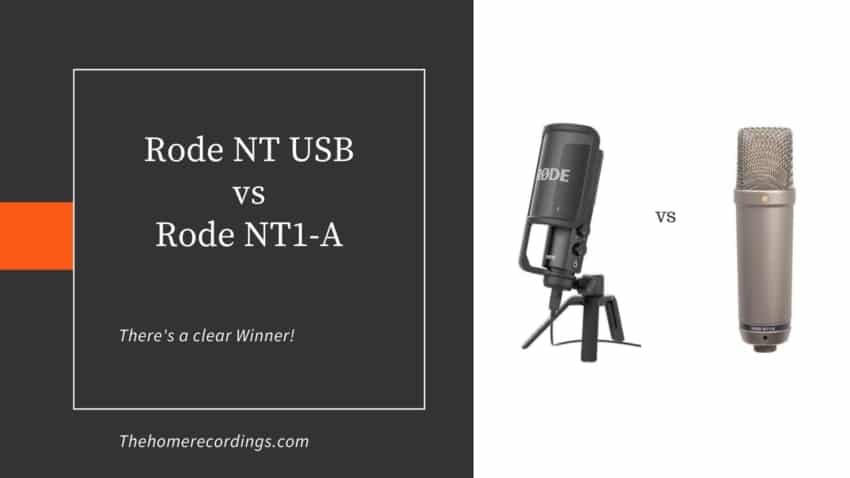
In this article I will be comparing the Rode NT USB and the Rode NT1a, and I will give you my honest opinion on which microphone you should choose… Spoiler alert, there’s a clear winner.
Let’s get started with the basic differences between the two…
Rode NT USB vs Rode NT1-a
The main difference between these two microphones is that the Rode NT connects to the computer via USB, while the Rode NT1a has an XLR connector on the bottom.
XLR connections are more versatile because they let you connect the microphone to more devices and not just a computer, such as Audio Interfaces, Mixers, Portable Recorders, etc.
In short, USB microphones are more “beginner friendly” than XLR ones for the simple fact that they are plug n’ play devices and that no additional equipment is required to use them.
In this particular case, the Rode NT1a is a vastly superior microphone overall, in fact, I use it in my home studio almost every day.
The only issue is that you would need to invest in an Audio Interface, and this will definitely be more expensive than getting the USB microphone, but it’s a much better setup in every way you look at it.
I wrote a post comparing USB microphones to XLR ones, their pros and cons, and much more, that you should definitely give a quick read before you decide what to do.
Now, let’s get into the microphones themselves.
Rode NT USB
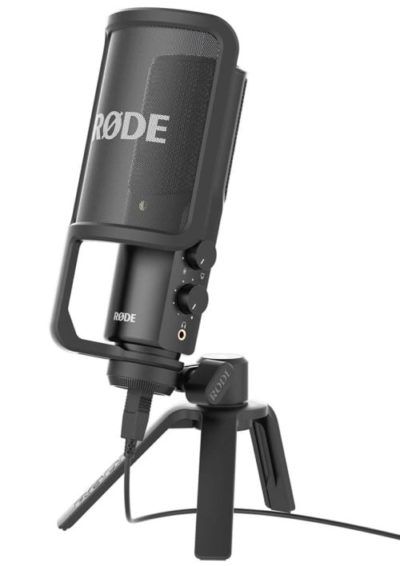
Rode NT USB Microphone.
The Rode NT USB is a pretty good Condenser USB cardioid microphone… Emphasis on “Pretty Good”.
Rode is known for making extremely high-quality equipment at reasonable prices, and the Rode NT USB is no exception to this rule, except for one thing, which I’ll mention in a second.
It comes with a pop filter, a tripod desk stand, a ring mount, a USB cable, and a storage pouch.
The two controls on the side are for the headphone volume, which comes in handy when you want to do zero latency monitoring, and the Direct mix control between mic input and source output.
This means that you can choose to hear only what’s coming out of the PC, to only hear the direct signal from the Mic, or a blend of those.
Now, you might have noticed that it doesn’t come with a Gain dial, which for a mic in this price-range is just ludicrous.
In all honesty, I don’t like this at all…
You can control the levels from your PC however, but this isn’t ideal since it simply takes too much time.
This microphone is good for recording singing, as well as spoken word; such as podcasting and voice-over, YouTube videos, etc.
When looking at the build quality I have to say that it’s excellent; the microphone itself is super heavy and completely made of metal, and the knobs on the side don’t wiggle one bit.
Like I mentioned, it includes a pop filter, which is rare since most microphones don’t include one, but this pop filter is made of plastic, so be careful with it.
As far as the pickup pattern goes, it’s a Cardioid microphone, meaning that it only picks up sound coming from the front while rejecting anything hitting it from the sides or rear.
Lastly, it works on Windows and Mac OS based computers, as well as the Apple iPad, and all you have to do is plug it in and that’s it.
How does it perform?
To be honest, I wasn’t as surprised as I thought I would be when trying out this mic.
For spoken word applications or for quiet singing it works super well, however when recording instruments that are a bit too loud, or any other loud sound source for that matter, even if the signal doesn’t clip it will sound as if it’s clipping.
Note: Clipping is that distortion sound you hear when the signal is too loud.
Also, having no Gain dial makes it a bit of a pain to set the levels correctly.
Other than that, I think that the Rode NT USB does a pretty decent job at doing what it’s supposed to do, just remember to not record very hot signals.
What comes in the box?
- The Rode NT USB Microphone
- Pop Filter
- Microphone Stand
- Microphone Mount
- Storage Pouch
Features
- Polar Pattern: Cardioid
- Pop shield, Tripod desk stand, ring mount, storage pouch and 6m (20’) USB cable included
- Includes Headphone Jack
- Frequency Response: 20Hz -20KHz
- Sample Rate: 48KHz/16-bit
Specifications
- Polar Pattern; Cardioid
- Frequency Response: 20Hz- 20kHz
- Sample Rate: 48kHz/16-bit
- Max SPL: 110dB
- Weight: 520g
Find out more about the Rode NT USB here.
Rode NT1a
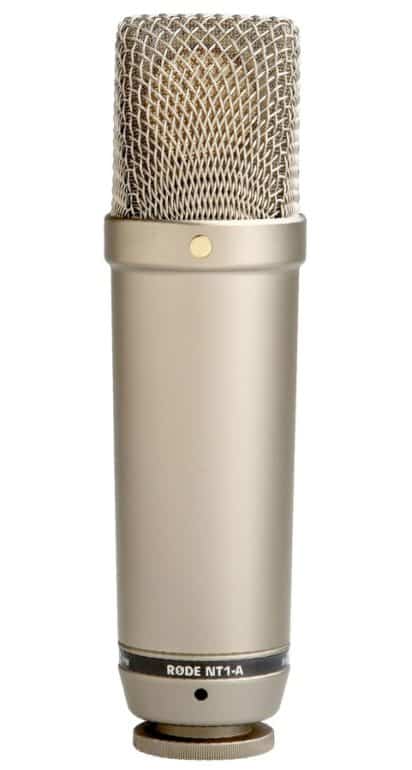
Rode NT1-A Microphone.
The Rode NT1a is one of the most famous and used microphones in the recording industry.
Some people praise it as if it were the best microphone to be ever created and they even compare it to other ones that are in a much higher price range.
The reason why the Rode NT1a is so good is because it will give you a very accurate representation of what is being recorded, meaning that it should easily fit within any mix.
It has a very natural sound, even though after reading some reviews online I found that people complained about it having a bit of a harshness, or high frequency/presence boost, which is actually quite common on microphones at this price range.
However, this all depends on your specific taste, since every microphone will have its own character.
Some people might find that it enhances their voice, while others may find that it makes their voice sound horrible and shrill.
What I’ve found over the years is that having that boost just gives the sound -especially vocals- a pre-produced sound and the tracks usually need a bit less EQing to fit in the fix.
Now, as far as the build quality goes, I honestly can’t complain at all!
It’s absolutely fantastic and it’s built to last.
Sadly, the Rode NT1a doesn’t come with a PAD or High–Pass filter, it’s just the bare microphone, but it is a great performer and it does what it’s supposed to do.
It has a slight boost at around 150Hz and at the 6k to 12kHz range, with a deep cut at the high-end; all this means that it will be actually quite bright sounding, which is what I referred to earlier by saying that people found it to be a bit harsh at times.
How does it Perform?
I found it great for recording vocals, acoustic guitar and electric guitar, but to be honest… once you get to this level of microphone it gets hard to really find one that doesn’t sound great.
It all comes down to your own preferences, what kind of tone you’re going for, etc.
I actually do like the high-end boost a bit since it gives it a more “airy” sound, plus it helps the tracks to better fit in the fix, like I mentioned.
This is also something that works well with acoustic guitars, since that high-end boost really opens up the higher frequencies, making the guitar sound better.
As I mentioned earlier, it all depends on your personal taste.
If you want a microphone that has an identical build quality but sounds a bit darker, then check out the Rode NT1.
You can find that one in my post about the best microphones under $300.
- The build quality is fantastic.
- The shock mount is metal, when most included ones are made of plastic.
- It’s insanely quiet (Low self-noise).
- Open and Airy high-end.
- Can Handle high SPL.
- The presence boost could make your recordings too bright. It can also you make your vocals a bit more sibilant.
- The included cable isn’t the best one.
What comes in the Box?
- The Rode NT1a microphone.
- A Storage Pouch.
- You also get the shock mount which comes with a pop filter already attached.
- XLR cable.
Specifications
- Polar Pattern: Cardioid
- Frequency Response: 20Hz – 20kHz
- SPL: max 137dB
- Impedance: 100 Ohms
- Sensitivity: -32dB
- Self Noise: 5dB
Find out more about the Rode NT1a here:
Which one should you Choose?
USB microphones are simple to use, but if you ever want to upgrade you will need to ditch the microphone entirely and get new equipment.
This is why I’m always in favor of purchasing an Audio Interface and an XLR microphone/s.
In this particular case, the Rode NT1a has the Rode NT USB beat by a mile; I would never recommend the Rode NT USB to anyone over the NT1a since there’s a huge difference in sound quality between the two.
If you’re certain that you need a USB microphone and that upgrading later on won’t be necessary, then I’d advise you to look into either the Samson G-Track Pro or the Blue Yeti.
Lastly, if you are someone who is looking to make music from home, run a podcast with guests, or anything similar, then definitely get an Audio Interface with more than one Input and purchase separate XLR mics.
Note: XLR connections will also yield a better audio quality since they are designed to reduce noise.
Conclusion
It’s hard to beat the Rode NT1a, I mean they use it in high-end studios all the time.
The Rode NT USB on the other hand, doesn’t have a Gain Control, which doesn’t make any sense, plus if you ever want to be able to record multiple sources, you would end up having to purchase an Audio Interface with XLR microphones anyway.
So, in my opinion, go with the Rode NT1a, no questions asked.
I hope this was useful!
Have a nice day!
About The Author
Facundo
For years now I’ve been interested in music production. I’ve worked in a music studio a couple of years back and now I mostly record at home and try to learn as much as I can about producing music and about the gear that is required to do so. This is something I really enjoy doing. The whole point of this Website is to help you and others learn more about how to produce music, especially from home.
Rode NT1-A Review (Great Budget Microphone For Home Recording)
A large reason for that is the low price. It is rare to find a condenser microphone selling in this price range.
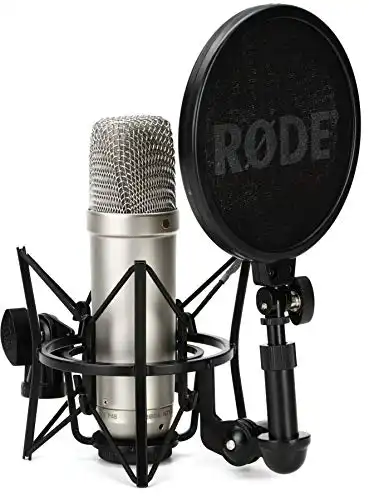
- Great build quality
- Good capture tone
- Specialized for vocals
- 10-year warranty
- Well-worth the price
- Lack of controls, especially the low cut filter
- Not versatile
Naturally, this microphone can’t compete with much more expensive professional level models.
But where exactly does it fall behind? What do you lose by saving money on this mic instead of spending more on a higher-quality one?
The good news is: not as much as you might think.
The NT1-A is not the mic for you if you want to record vocals professionally, but if you are just starting out as a singer or podcaster and you need a budget microphone to record yourself at home, it is by far the best choice out there.
Let’s take a closer look at everything this mic delivers, despite the low cost. We’ll also compare it to two other hugely popular alternatives.
Rode NT1-A Microphone Review: Overview And Features

No matter your style of music or preferred vocal techniques, you just can’t get good recordings without a proper condenser microphone. But we all know how expensive these mics can get, which may discourage you from wanting to get one for home recording purposes.
Fortunately for all the enthusiasts who don’t want to (and probably don’t need to) shell out tons of money for a full-on professional mic like the Neumann TLM 103, there are some fairly affordable options. One of the best is the Rode NT1-A.
It’s a classic large-capsule microphone, featuring a gold-plated diaphragm. This condenser mic is very well-known for its warm tone, while still managing to keep some brightness and clarity in there.
This is mostly due to its specific voicing, i.e. the distribution of frequencies over the spectrum. While covering anything between 20 and 20,000 Hz (pretty much the entire audible spectrum), there are a few boosts in certain frequencies, specifically in the lower and higher-end.
As for the pickup pattern, the NT1-A is a standard cardioid microphone. It’s also worth noting that it has a pretty good dynamic range, making it capable of capturing even the slightest nuances or distant sounds and vocals. Self-noise is extremely low, somewhere at 5 decibels.
Last, but not least, it features internal capsule shock mounting and comes with Rode’s specialized external shock mount, a dust cover, and a pop filter. Rode also gives you a 10 year warranty.
Key Features
- True condenser microphone
- Cardioid pickup pattern
- Covers anything from 20 Hz to 20 kHz
- Has a unique voicing that gives some warmth and clarity to the tone
- Low self-noise, 5 dB (A)
- Handles noise of up to 137dB SPL
- Internal capsule shock mounting
- Comes with a shock-mount, pop filter, and a dust cover

- Great build quality
- Good capture tone
- Specialized for vocals
- 10-year warranty
- Well-worth the price
- Lack of controls, especially the low cut filter
- Not versatile
Sound Capture Quality
As mentioned, Rode’s NT1-A captures anything within the audible spectrum, having a frequency response of 20 Hz to 20 kHz. But its main characteristics and strengths are heard in its recordings.
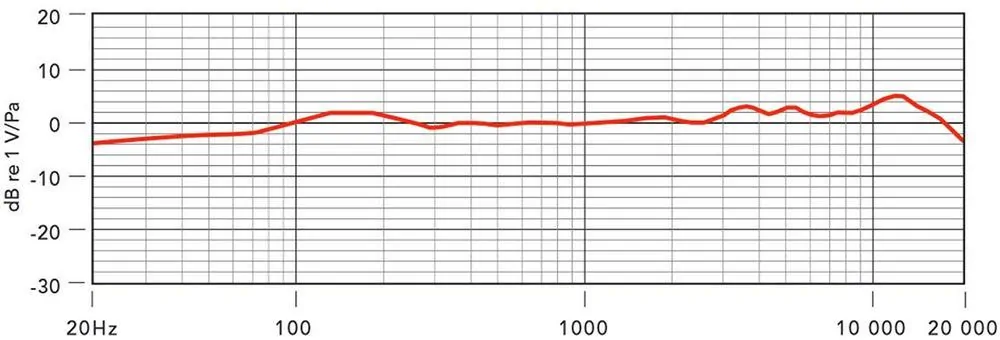
First, the microphone features no low cuts, and anything from 20 to 100 Hz is mostly flat. Then we notice a boost beginning somewhere between 90 or 100 Hz and going up to about 250 Hz.
There are a few bumps on the curve in the mid and higher mid area, somewhere between 2 and 6 kHz. It reaches its peak at around 12 and 13 kHz and then drops sharply after about 15 kHz.
Looking at this data, it’s pretty clear that this is somewhat of a “scooped” microphone, giving that bottom-end boost with additional high-end clarity. It’s somewhat unusual, as condenser vocal mics are generally focused on having a flatter distribution across the spectrum, with occasional boosts only in the highs and high mids.
But this curve works. The NT1-A does an incredible job with vocal recording, including spoken parts. This response can be attributed to its pressure gradient acoustic principle.
But this has a downside as well. Recordings might get a little “bassy” due to the curve’s lower end, which can result in those “popping” low-end sounds to the vocals. The included pop filter helps a lot.
What’s also worth noting is its extremely low self-noise. Levels even above 10 dB are considered to be low, but this Rode mic features only 5 dB, which is practically unnoticeable in the mix. Some significantly more expensive microphones, like Neumann’s TLM 103, have a higher self-noise rate compared to NT1-A.
Classic Design
This is a classic large-diaphragm condenser microphone, following all the set industry standards. It features a 1-inch capsule that has a gold-plated diaphragm. Another important feature is its internal shock-mounted design.
The mic is not that heavy, weighing in slightly below 330 grams, or about 0.7 pounds. It’s pretty sturdy on the outside, and the inclusion of the internal shock mount makes it pretty resistant to rougher handling. That said, this might be a bit overkill, as the microphone is intended for studio work and doesn’t generally see any live stage action.

As stated, this is a microphone for recording vocals. As a budget mic, it is generally used in home studios, but it can handle professional studio recordings as well, though in studios it is mostly used for backing vocals. However, the cardioid pattern is perfect for solo vocal performances.
It has somewhat high noise handling, but the microphone’s voicing isn’t ideal for on-stage uses. It could potentially come in handy for some acoustic instruments, including guitars, strings, and even some louder stuff, like trumpets and other brass instruments. But if you have more funds at your disposal, a microphone with a “flatter” response would be a more suitable choice for those purposes.
The same goes for loud electric and bass guitar amps. You can technically use them, but you’ll need to set up the EQ right and do some additional tweaking in the mix. However, live usage would be complicated for guitar amps, in large part because the mic can capture some unwanted noises.
The NT1-A has no additional controls. That makes it easy to use, but having additional options can always come in handy with any condenser microphone. Having a few pickup patterns can help in implementing it in different settings, and a low-end cutoff filter would certainly make things easier with any vocal recording.
Rode NT1-A: Advantages And Disadvantages
- Great build quality
- Good capture tone
- Specialized for vocals
- 10-year warranty
- Well-worth the price
- Lack of controls, especially the low cut filter
- Not versatile
Rode NT1-A Vs AT2020

Since the Rode is a budget alternative to higher quality, and much more expensive, condenser mics, it only makes sense to compare it to one of the most popular budget mics on the market: the Audio-Technica AT2020.
That said, there is really no comparison. The NT1-A is a much better microphone. Not that the AT2020 is bad. It was designed to be a very affordable home recording and podcasting microphone. It does those things well and sells for a very low price. The Nt1-A does those things better and costs more.
They’re both condenser microphones with cardioid pickup pattern. However, one of the first things you notice is the AT2020’s significantly higher self-noise of 20 dB SPL. And while it’s flatter in the overall frequency response, it still has almost no low-end cut off.
There’s a slight boost in the higher mid and high end, but the tones are, overall, less “scooped” than those of the NT1-A. The full frequency scope is exactly the same for both of these mics. The AT2020 does have one little advantage with a higher noise handling of 144 dB SPL.
Audio-Technica’s mic is an affordable solution for vocal recording. You won’t get the warmth and other qualities that the NT1-A provides, but it costs a lot less and gives enough of a punch for the price.
It’s great for home recording or things like podcasts, but it’s not suitable for professional applications. If you’re starting a podcast or just want to record some vocals for fun or YouTube, the AT2020 is a great choice. If you want a bit more quality, the AT2035 is also a good option that doesn’t cost too much more.
But if you want to create professional level vocal recordings, be it singing or rapping or speaking, the Rode NT1-a is the perfect choice for anyone on a budget. If you have a bit more money to spend, check out the next section below.
Rode NT1 vs Shure SM7B
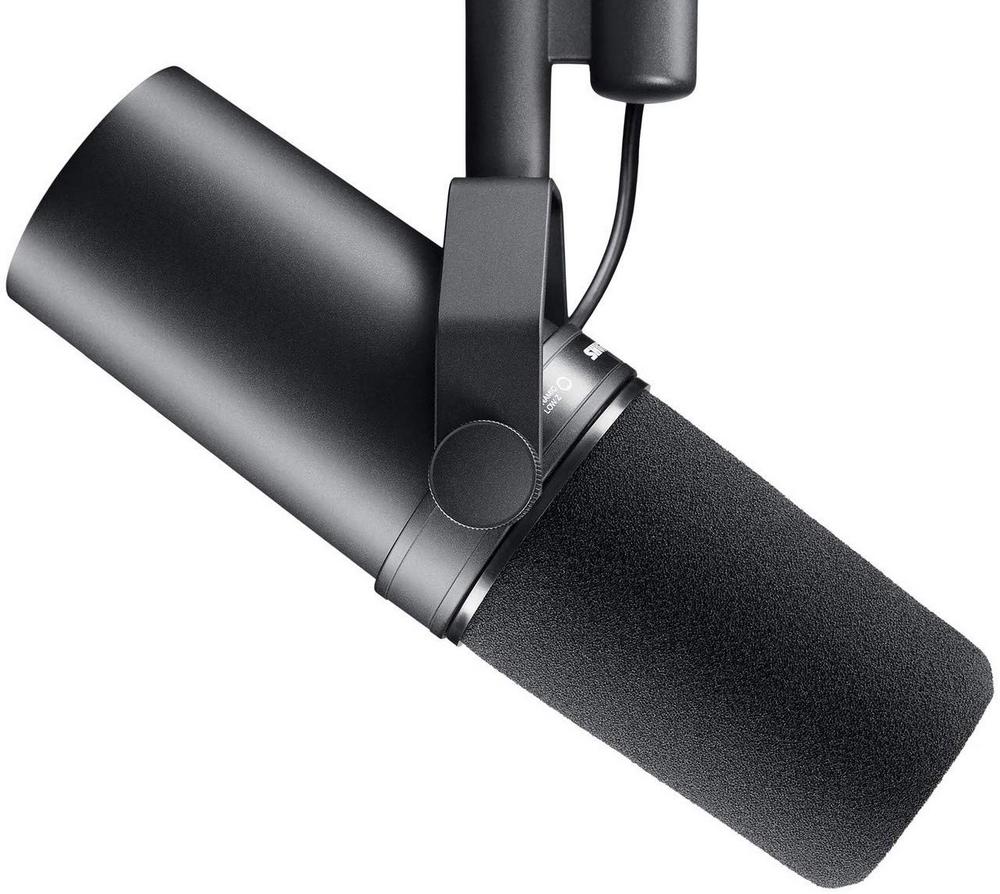
Shure’s SM7B is a higher-end option. Although it has a slightly narrower frequency scope, from 50 Hz and up to 20 kHz, it has a flatter territory in the mid-section and a slight low-end cutoff. As a result, the SM7B generally works better for solo vocals or speech at closer proximity than the NT1-A.
It’s pretty similar when it comes to the overall features, like the polar pattern and lack of controls. What makes the SM7B very interesting is the specially designed internal shock isolation, with gets rid of all the potential unwanted mechanical noise. The mic also has its own pop filter that allows some low-end roll-offs for more stable vocal performance.
The whole thing is rounded out with a very sturdy build and a more modern design. It only takes a quick glance to see that the Shure is more expensive than the Rode.
But there is one big difference. Even though both mics are designed for home and studio recordings, the Shure is actually a dynamic mic. These are generally preferred for live performances, but Shure has delivered a dynamic mic that is ideal for studio work. It is the better option here for recording studio vocals, but it also costs more. If you are on a budget, the Rode is easily your best option.
Rode NT1A Review: Conclusion And Rating
Although not very versatile, the Rode NT1-A is a solid microphone for a very good price. Though it sits somewhere between inexpensive and expensive, it is actually a great price when you consider that you’re getting a quality condenser mic.
It is so good that you’ll find it in some professional studios, but it’s more of a higher-end home recording solution with its design and features. For professional work, you’ll probably want to spend a bit more and get something like the Neumann TLM 103.
As expected for a budget mic, a few useful features are missing. An additional switch for a low-end cutoff would be nice, and it’s not clear why such a simple and useful feature was not included. Depending on the setting, it might get a little tricky to work with, as some consonants might cause sudden boosts and pops in the lower end. You definitely want to use the included pop filter.
If you want recording quality that comes close to the professional level, but that costs far less, the Rode NT1-A is by far the best option on the market. But there are obviously better mics out there (that also cost a lot more). That is why the Rode gets an overall Musicaroo rating of 4.5 out of 5.
Источник http://radiozvuk.com/community/topic/1282-rode-ntk-i-rode-nt1a/
Источник https://thehomerecordings.com/rode-nt-usb-vs-rode-nt1-a/
Источник https://musicaroo.com/rode-nt1a-review/
